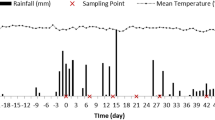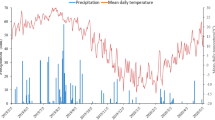Abstract
The study intended to design, develop and evaluate mechanical interface on the basis of physical, engineering and mechanical properties of paddy straw for size reduction. The mechanical interface comprised of loose straw collector, stalk chopper, conveyor, applicator and discharging unit. A 300 L plastic cistern containing fungal inoculum dose prepared from Aspergillus nidulans, Aspergillus awamori, Phanerochaete chryosporium and Trichoderma viride was installed to apply the fungal inoculum uniformly @1000 g per 1000 kg of the chopped straw. The chopped straw was subjected to degradation in rectangular strips with and without inoculant overhead and rotavator incorporated with soil. The treated straw assimilated with the soil bolstered the nitrogen content to 182.0 kg ha−1, phosphorus 63.5 kg ha−1, potassium 1862.5 kg ha−1 and organic carbon 0.51% from initial value of 110.6 kg ha−1, 42.8 kg ha−1, 1068.4 kg ha−1 and 0.33%, respectively. In S3, the soil–straw–microbe interaction provided feasible conditions for the microbial growth, depicted from 53.5% upsurge in dehydrogenase activity to 111.04 µg TPF g−1 per 24 h. The surge in microbial growth coincided with the 16.8% increase in biomass consumption and releasing of CO2 from 272.8 to 319.1 milligram within first phase of degradation. The rapid growth of the microbes at the initial stage decreased the moisture and resources essential for sustaining the growth. In the final stage, the dehydrogenase activity and biomass content decreased 6% to 105.04 µg TPF g−1 per 24 h and 23.7%, decreasing the emission of carbon dioxide to 307.1 mg within 45 days degradation period. The variation in the emission at the last stage can serve as ammunition to fight carbon dioxide induced global climate change.







Similar content being viewed by others
References
A. Dobermann, T. H. Fairhurst, Rice straw management. Better crops Int. 16(Sp. Supp. May), 7–9 (2002). https://www.ipni.net/ppiweb/bcropint.nsf.
M. Choudhary, P. Sharma, H. Jat, A. McDonald, M. Jat, S. Choudhary, N. Garg, Soil biological properties and fungal diversity under conservation agriculture in indo-gangetic plains of India. J. Soil Sci. Plant Nutr. 18(4), 1142–1156 (2018). https://doi.org/10.4067/S0718-95162018005003201
S. Sarkar, Management practices for enhancing fertilizer use efficiency under rice–wheat cropping system in the IndoGangetic plains. Innovare J. Agric. Sci. 3, 5–10 (2015)
Food and Agricultural Organisation (FAO), FAOSTAT Database (Food and Agricultural Organization, Rome, 2014)
P. Binod, R. Sindhu, R.R. Singhania, S. Vikram, L. Devi, S. Nagalakshmi, N. Kurien, R.K. Sukumaran, A. Pandey, Bioethanol production from rice straw: an overview. Bioresour. Technol. 101, 4767–4774 (2010)
L. Shukla, A. Suman, A.N. Yadav, P. Verma, A.K. Saxena, Syntrophic microbial system for ex-situ degradation of paddy straw at low temperature under controlled and natural environment. J. Appl. Biol. Biotechnol. 4(02), 030–037 (2016)
B.C. Saha, Hemicellulose bioconversion. J. Ind. Microbiol. Biotechnol. 30, 279–291 (2003)
B.S. Dahiya, R.B. Srivastava, J. Singh, Impact of intensive agriculture on environment, in Environmental Pollution and Global Health. ed. by R.P. Saharanm, P.K. Sareen (EMSI, BARC, Mumbai, 2007), pp. 3–16
L.N. Shukla, H.S. Sidhu, V. Bector, Design and development of loose straw thrower attachment for direct drilling machines. AET 26(3–4), 23–29 (2002)
S. K. Bansal, Studies on effect of direct drilling technologies on wheat crops under different paddy residue conditions. M. Tech. thesis, Punjab Agricultural University, Ludhiana, India (2002).
R.L. Kushwaha, A.S. Vaishnav, G.C. Zoerb, Soil bin evaluation of disc coulters under no-till crop residue conditions. Trans. ASAE 29(1–3), 40–44 (1986)
M.G. Cameron, G.C. Fahey, J.H. Clark, N.R. Merchen, L.L. Berger, Effects of feeding alkaline hydrogen peroxide-treated wheat straw-based diets on intake, digestion, ruminal fermentation, and production responses by mid-lactation dairy cows. J. Anim. Sci. 69(4), 1775–1787 (1991)
E. Natarajan, A. Nordin, A.N. Rao, Overview of combustion and gasification of rice husk in fluidized bed reactors. Biomass Bioenergy 14, 533–546 (1998)
H. Shindo, T. Nishio, Immobilization and remineralization of N following addition of wheat straw into soil: determination of gross n transformation rates by 15N-ammonium isotope dilution technique. Soil Biol. Biochem 37, 425–432 (2005)
A.K. Pandey, S. Gaind, A. Ali, L. Nain, Effect of bioaugmentation and nitrogen supplementation on composting of paddy straw. Biodegradation 20, 293–306 (2009)
A. Singh, I.S. Dhaliwal, A. Dixit, Performance evaluation of tractor mounted straw chopper cum spreader for paddy straw management. Indian J. Agric. Res. 45(1), 21–29 (2011)
H. Kausar, M. Sariah, H.M. Saud, M.A. Zahangir, M. Ismail Razi, Development of compatible lignocellulolytic fungal consortium for rapid composting of rice straw. Int. Biodeterior. Biodegrad. 64, 594–600 (2010)
H.L. Sharma, C.M. Singh, S.C. Modgal, Use of organics in rice-wheat crop sequence. Indian J. Agric. Sci. 57(3), 163–168 (1987)
F.D. Luis, G.M. Savage, L.L. Eggerth, G.G. Calarence, Composting and Recycling Municipal Solid Waste (Lewis Publication, London, 1993), pp. 121–175
M. Muzamil, I. Mani, L. Shukla, S. Lande, Efficiency of pusa compost inoculant along with windrow turner for rapid degradation of paddy straw. J. Pure Appl. Microbiol. 8(1), 569–576 (2014)
A. Kumar, S. Gaind, L. Nain, Evaluation of thermophilic fungal consortium for paddy straw composting. Biodegradation 19, 395–402 (2008)
G.C. Ainsworth, G.R. Bisby, Dictionary of the Fungi (Surrey, Commonwealth Mycological Institute Kew, 1995), p. 445
T.K. Lundell, M.R. Makela, K. Hilden, Lignin-modifying enzymes in filamentous basidiomycetes—ecological, functional and phylogenetic review. J. Basic Microbiol. 50, 5–20 (2010). https://doi.org/10.1002/jobm.200900338
A.J. Chang, J. Fan, X. Wen, Screening of fungi capable of highly selective degradation of lignin in rice straw. Int. Biodeterior. Biodegrad. 72, 26–30 (2012). https://doi.org/10.1016/j.ibiod.2012.04.013
M.J. Dinis, R.M.F. Bezerra, F. Nunes, A.A. Dias, C.V. Guedes, L.M.M. Ferreira, J.W. Cone, G.S.M. Marques, A.R.N. Barros, M.A.M. Rodrigues, Modification of wheat straw lignin by solid state fermentation with white-rot fungi. Bioresour. Technol. 100, 4829–4835 (2009). https://doi.org/10.1016/j.biortech.2009.04.036
C. Wan, Y. Li, Microbial delignification of corn stover by Ceriporiopsis subvermispora for improving cellulose digestibility. Enzym Microb. Technol. 47, 31–36 (2010). https://doi.org/10.1016/j.enzmictec.2010.04.001
M. Maza, H.F. Pajot, M.J. Amoroso, Post-harvest sugarcane residue degradation by autochthonous fungi. Int. Biodeterior. Biodegrad. 87, 18–25 (2014). https://doi.org/10.1016/j.ibiod.2013.10.020
S.S. Thakur, I.K. Garg, Paddy straw management by chopping for sowing wheat in combine harvested field. J. Res. Punjab Agric. Univ. 44(3), 243–248 (2007)
L. Shukla, A. Senapati, S.P. Tyagi, A.K. Saxena, Economically viable mass production of lignocellulolytic fungal inoculum for rapid degradation of agrowaste. Curr. Sci. 107(10), 1701–1704 (2014)
N. Jain, A. Bhatia, H. Pathak, Emission of air pollutants from crop residue burning in India. Aerosol Air Qual. Res. 14, 422–430 (2014). https://doi.org/10.4209/aaqr.2013.01.0031
Anonymous, Annual Report, Mechanization of rice-wheat cropping system for increasing the productivity (NATP project). Department of Farm Power and Machinery, Punjab Agricultural University, Ludhiana (2002).
Anonymous, Paddy straw management. Annual day ISAE (Punjab Chapter) held on 26th of Feb, at CAE, PAU, Ludhiana (1999).
M. Muzamil, I. Mani, A. Kumar, L. Shukla, S. Lande, A.K. Saxena, Optimization of straw size, dose of compost inoculant along with engineering and microbiological parameters for paddy straw degradation in shortest possible time. J. Pure Appl. Microbiol. 9(2), 453–461 (2015)
S. Singh, Annual report of project mechanization of rice–wheat cropping systems for increasing the productivity. Department of farm power and machinery, Punjab agricultural university, Ludhiana, India (2002)
Acknowledgements
The authors express their sincere appreciation to the INSPIRE programme of Department of Science of Technology, Government of India, for providing funds that led to the development of the technology to curb the menace of paddy straw burning and nutrient recycling.
Author information
Authors and Affiliations
Corresponding author
Ethics declarations
Conflict of interest
Authors have worked collectively to complete the objectives of the research study and have expressed that no competing interests exist.
Additional information
Publisher's Note
Springer Nature remains neutral with regard to jurisdictional claims in published maps and institutional affiliations.
Rights and permissions
About this article
Cite this article
Muzamil, M., Mani, I., Kumar, A. et al. An Engineering Intervention to Prevent Paddy Straw Burning Through In Situ Microbial Degradation. J. Inst. Eng. India Ser. A 102, 11–17 (2021). https://doi.org/10.1007/s40030-020-00490-0
Received:
Accepted:
Published:
Issue Date:
DOI: https://doi.org/10.1007/s40030-020-00490-0




